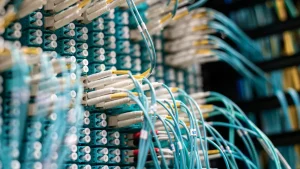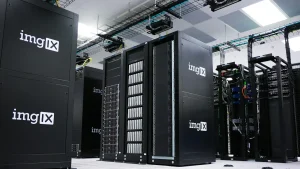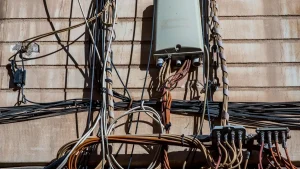
MPO trunk cables will become foundational for AI data centers by 2025. These cables enable the high-density, high-bandwidth interconnects essential for advanced AI workloads and infrastructure. The global AI Data Center Market is projected to reach USD 236.44 billion in 2025, demonstrating significant growth. This expansion demands robust networking solutions. For instance, an MPO Adapter connects various fiber types, while an MPO Breakout Harness Cable OM3/OM4/OS2 supports diverse applications. Specific solutions like MPO Trunk Cable OM1 and MPO/MTP fanout Harness SM also play crucial roles in these evolving environments.
Key Takeaways
- MPO trunk cables are important for AI data centers. They help connect many devices quickly.
- These cables have many fibers in one connector. This allows for fast data transfer and saves space.
- MPO cables help GPUs talk to each other very fast. This is key for AI training and operations.
- They support very high internet speeds like 400GbE and more. This meets the growing needs of AI.
- MPO cables make it easy to add more equipment. This helps data centers grow without big changes.
- They reduce cable mess. This improves airflow and keeps AI equipment cool.
- MPO cables save time and money during setup. They also make fixing problems easier.
- These cables are ready for future AI tech. They work with new ways to build AI systems.
The Foundational Role of MPO Trunk Cables in AI Data Centers by 2025
Defining MPO Trunk Cables for AI Infrastructure
MPO trunk cables are crucial for modern AI infrastructure. They provide the backbone for AI-driven networks. Their technical specifications make them ideal for demanding AI workloads. These cables offer a high fiber count, a pre-terminated design, and excellent scalability. They also ensure compatibility across various systems. MPO trunk cables support the ultra-low latency and high bandwidth essential for machine learning and real-time analytics.
Multi-Fiber Push-On Connectors
Multi-Fiber Push-On (MPO) connectors are central to these cable systems. They consolidate multiple optical fibers into a single connector. This design allows for rapid connection and disconnection. MPO connectors typically house 12, 24, or even 16 fibers in a compact ferrule. This significantly increases data transmission capacity. The MPO-16 fiber optic connector is emerging as the preferred choice for 400G transmission. Experts anticipate it will become the primary standard for future high-speed transmissions, including 800G and 1.6T. Its design improvements, such as the offset key, enhance reliability. This prevents incorrect insertions with MPO-12 connectors.
Pre-terminated High-Density Assemblies
MPO trunk cables come as pre-terminated, high-density assemblies. This means manufacturers assemble and test the cables in a factory. This process ensures high quality and performance. Pre-termination simplifies installation in the data center. It reduces the need for on-site fiber termination, which saves time and labor. These assemblies are critical for building efficient and reliable AI networks.
Key Characteristics Driving AI Adoption of MPO Trunk Cables
AI data centers require robust and efficient cabling solutions. MPO trunk cables possess key characteristics that drive their adoption in this sector.
High Fiber Count and Density
MPO trunk cables are designed for high-density fiber optic applications. They accommodate multiple fibers within a single connector. This significantly increases data transmission capacity. For example, MPO 16 cables are particularly advanced for AI infrastructure. They pack 16 fibers into a single connector. This offers a 33% higher port density than traditional 12-fiber MPOs. Meta’s RSC-2024 AI SuperCluster uses 16,384 MPO 16 cables. These cables interconnect 24,576 NVIDIA GB200 GPUs. This demonstrates their capability to achieve massive fiber counts in compact spaces. They also reduce cabling mass by 28 tons compared to MPO-12 solutions.
Space Efficiency in Racks
MPO cables significantly reduce cabling clutter. They integrate multiple fibers into a single connector. This optimizes rack space and improves airflow in data centers. MTP/MPO trunk cables excel in high-density fiber patching. This significantly reduces cable management issues. Base-8 and Base-16 connection solutions feature a compact design. This makes them ideal for high-density deployment in AI computing environments with limited cabinet space. Fewer cables lead to clearer cabling paths and lower air resistance. This facilitates more effective heat dissipation. Each MTP-16/MPO-16 interface can accommodate 16 fibers. This significantly increases connection density per unit of space. It allows more ports to fit into a smaller area.
MPO Trunk Cables: Powering High-Speed AI Interconnects
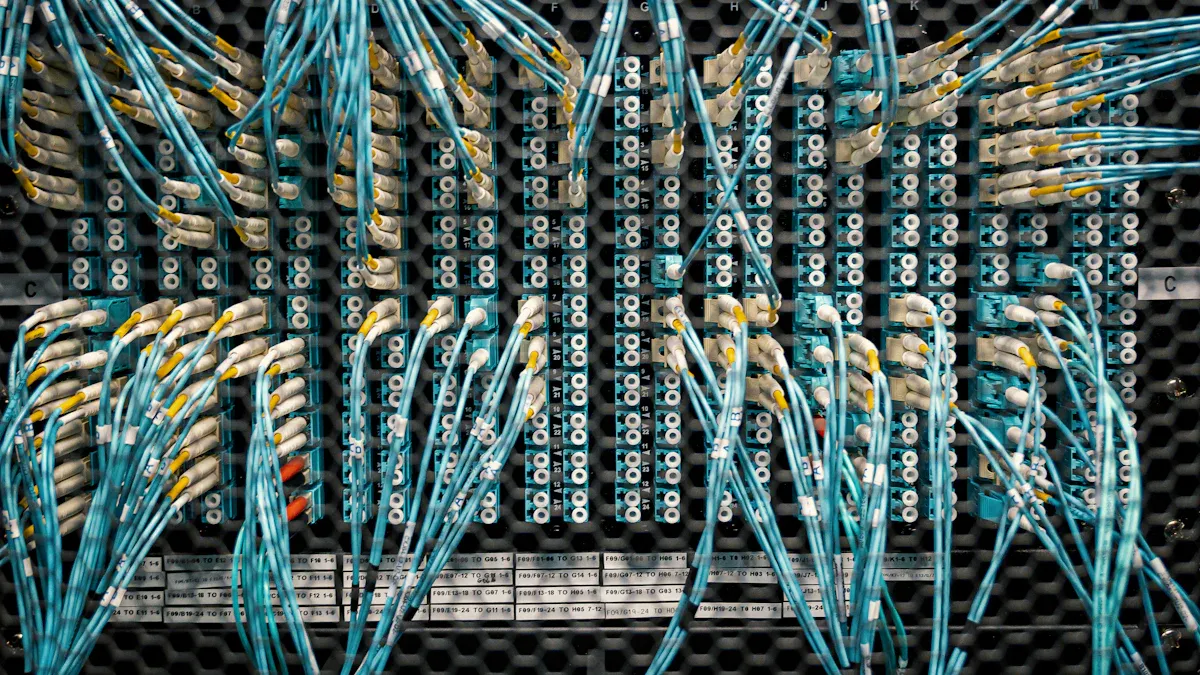
MPO trunk cables are essential for the high-speed interconnects that power AI data centers. They provide the necessary bandwidth and low latency for demanding AI workloads. These cables ensure efficient data flow across complex AI infrastructures.
Enabling Ultra-Fast GPU Communication
AI data centers rely heavily on powerful Graphics Processing Units (GPUs). MPO trunk cables play a critical role in connecting these units.
Direct GPU-to-GPU Links
AI models, especially large language models, require immense computational power. GPUs communicate directly to share data and synchronize operations. MPO cables facilitate these direct links, ensuring minimal latency and maximum throughput. This direct connection often bypasses traditional network switches in some architectures, speeding up data exchange between processing units.
AI Cluster Fabric Connectivity
MPO cables form the backbone of AI cluster fabrics. These fabrics connect thousands of GPUs, enabling them to function as a single, powerful supercomputer. Currently, switch-to-switch connections in AI cluster backends predominantly operate at 800 Gigabits. These connections utilize 16-fiber MPO connectors, with 8 fibers for transmitting and 8 for receiving at 100 Gb/s each. Furthermore, some major hyperscalers and large cloud service providers are already adopting 1.6 Terabit switch connections for their backend infrastructure. This involves using two 16-fiber MPO connectors. This high-capacity connectivity is vital for distributing massive datasets and model parameters across the cluster efficiently.
Supporting Next-Generation Ethernet for AI
The rapid evolution of AI demands network infrastructure capable of supporting ever-increasing data speeds. MPO cables are central to this evolution.
400GbE and Beyond
AI applications demand ever-increasing data transmission speeds. MPO connectors are best suited for 400G applications due to their high bandwidth and lower loss. These characteristics are crucial for efficient data transfer. These components are essential for the steady development and growth of network potential, meeting the industry’s growing appetite for throughput and low latency. The volume of incoming data complements nascent technologies such as artificial intelligence and machine learning, ensuring data center operations remain relevant amidst the changing nature of the digital world. The escalating demand for higher data transmission speeds, driven by cloud computing, big data analytics, and AI applications, necessitates adopting higher fiber count MPO connectors and cables. This pushes the boundaries of density and performance.
As IBM’s VP of Cloud Infrastructure, Dr. Sarah Aerni, notes, “MPO 16 isn’t just about density—it’s the foundation for rearchitecting exascale systems with photonic determinism.”
MPO-16 cables offer significant advantages for these high-speed requirements:
| Feature | Description |
|---|---|
| Fiber Count | Consolidates 16 fibers into a compact form factor; supports up to 16 fiber connections per connector, significantly increasing connection density compared to traditional 8 or 12 fiber connectors. |
| Transmission Rates | Enables 400Gbps links by utilizing 8 fibers for transmission (Tx) and 8 for reception (Rx); supports 400G and higher transmission rates, including 800GbE systems. |
| Ethernet Protocols | Fundamental for implementing ultra-high-speed Ethernet, facilitating 400G Ethernet and faster standards like 400GBASE-SR8 (using a 50 Gb/s lane rate). MMC-16 cables (a type of MPO-16) support 2×400 Gig, 800 Gig, and 1.6 Terabit (2×800 Gig) applications, with future capability for 3.2 Terabit (2×1.6 TB) applications with 200 Gb/s lane rates. |
| Density & Latency | Offers 33% higher port density than traditional 12-fiber MPOs, reducing hyperscale deployment costs. Reduces latency by enabling higher-speed Ethernet protocols and optimizing data aggregation at the edge. |
| AI & 5G Integration | Designed to meet the demands of AI, 5G-Advanced networks, and quantum computing; integrates seamlessly with private 5G networks as a high-capacity wired backbone. |
| Advanced Features | Innovations include nano-fabricated ferrules, self-diagnostic capabilities, and sustainable materials. Features like Quantum-Secure Shielding integrate anti-tamper FBG sensors and 50 dB crosstalk suppression. Self-monitoring cables embed MEMS sensors to detect microbends and temperature spikes, enabling SDN rerouting before signal degradation. |
Meta’s RSC-2024 AI SuperCluster deploys 16,384 MPO 16 cables to interconnect 24,576 NVIDIA GB200 GPUs, reducing cabling mass by 28 tons. Ericsson’s Streetmacro 6705 radios use waterproof MPO 16 cables for 25G eCPRI interfaces, enabling Verizon’s 2024 C-band rollout with less than 50 μs latency.
Parallel Optics Transmission for MPO Trunk Cables
The increasing prevalence of parallel optics in high-speed networking, such as 400GbE and 800GbE, directly translates into a greater reliance on MPO connectors for transmitting multiple optical signals simultaneously. Advancements in fiber technology, including bend-insensitive fibers and low-loss connectors, are enhancing the reliability and performance of MPO trunk cable assemblies, allowing for more flexible routing in confined spaces. Parallel optics transmission significantly enhances data throughput for AI workloads.
- MPO cabling supports parallel transmission and high fiber counts. These are crucial for the massive GPU-to-GPU communication and terabit speeds required by AI workloads like deep learning training and large language models.
- Parallel optics enable simultaneous multi-lane data transfer, a key benefit for AI infrastructure.
- MPO ensures low-latency, high-bandwidth connectivity vital for training large AI models.
- MPO provides high-density connections, reducing cabling clutter and saving space. This contributes to enhanced data throughput by optimizing physical infrastructure.
Scalability and Agility with MPO Trunk Cables in AI Architectures
AI data centers require infrastructure that can grow and adapt quickly. MPO trunk cables provide the modularity and space efficiency necessary for these dynamic environments. They enable data centers to scale operations without extensive overhauls.
Modular Design for AI Data Center Growth
MPO trunk cables offer a modular approach to network design. This design is crucial for AI data centers that experience rapid growth and changing demands.
Pay-as-You-Grow Expansion Strategies
The modular design of MPO solutions directly contributes to cost savings and faster expansion cycles. This supports a "pay-as-you-grow" strategy. AI infrastructure can adapt to rising demands from AI clusters, cloud computing, and video streaming. It does this without incurring prohibitive costs associated with extensive overhauls. MPO trunk cables, while potentially more expensive initially, offer significant long-term cost savings in AI infrastructure. They achieve this by avoiding frequent upgrades and replacements. This leads to better overall value and performance over time. This "pay-as-you-grow" approach allows for easier expansion. It also reduces reconfiguration work. This justifies the higher initial investment through reduced operational costs and future-proofing against increasing bandwidth demands.
Simplified Network Upgrades
MPO trunk cables simplify network upgrades significantly. Their pre-terminated nature means technicians can quickly swap out or add new cable assemblies. This reduces the time and complexity involved in expanding or reconfiguring the network. Data center operators can easily upgrade from lower-speed connections to higher-speed ones. They simply replace existing MPO modules with new ones that support faster Ethernet standards. This modularity minimizes disruption to ongoing AI workloads.
Optimizing Physical Space with MPO Trunk Cables
Space is a premium in AI data centers. MPO trunk cables help optimize physical space, which improves overall operational efficiency.
Reduced Cable Congestion
MPO trunk cables significantly reduce the amount of cabling and pathway congestion. They do this compared to using individual patch cords. A single 72-fiber MPO/MTP trunk cable can replace up to 36 traditional duplex fiber patch cords. This drastically cuts down cable congestion. MPO trunk cable assemblies offer multiple benefits in data center implementations due to their efficiency and scalability. They facilitate high-density connectivity, which is crucial in space-constrained data centers. This efficient use of space results in better organization and management of cable systems. It leads to less congestion in the work area and improved maintenance. This indirectly supports better airflow by reducing physical obstructions.
Enhanced Airflow and Cooling Efficiency
Reduced cable clutter from MPO trunk cables leads to improved airflow. This enhances equipment cooling and overall efficiency. Enhanced airflow, facilitated by structured cabling including MPO trunk cables, significantly improves cooling efficiency in AI data centers. By promoting unobstructed airflow, these cables enable Computer Room Air Handler (CRAH) units to consistently deliver cold air. This is critical for air-cooled halls operating at or above 100 kW. The use of high-density fiber, such as 24-strand MPO trunks, minimizes cable bundle width. This creates valuable space for coolant manifolds and further optimizes cooling strategies. This improved cooling efficiency directly translates to lower power consumption. Operators can raise chiller set points and reduce Power Usage Effectiveness (PUE) by 10–20 percent. This leads to lower power bills and optimized energy use.
- Improved Cooling Efficiency: Structured cabling ensures unimpeded airflow. This allows CRAH units to maintain consistent cold-air delivery. This is especially crucial for high-density air-cooled halls.
- Reduced Power Consumption: Enhanced cooling efficiency enables operators to raise chiller set points. This leads to a 10–20 percent reduction in PUE and lower power bills.
- Optimized Energy Use: The overall system leads to optimized energy consumption and predictable performance.
Operational Advantages of MPO Trunk Cables for AI Operations
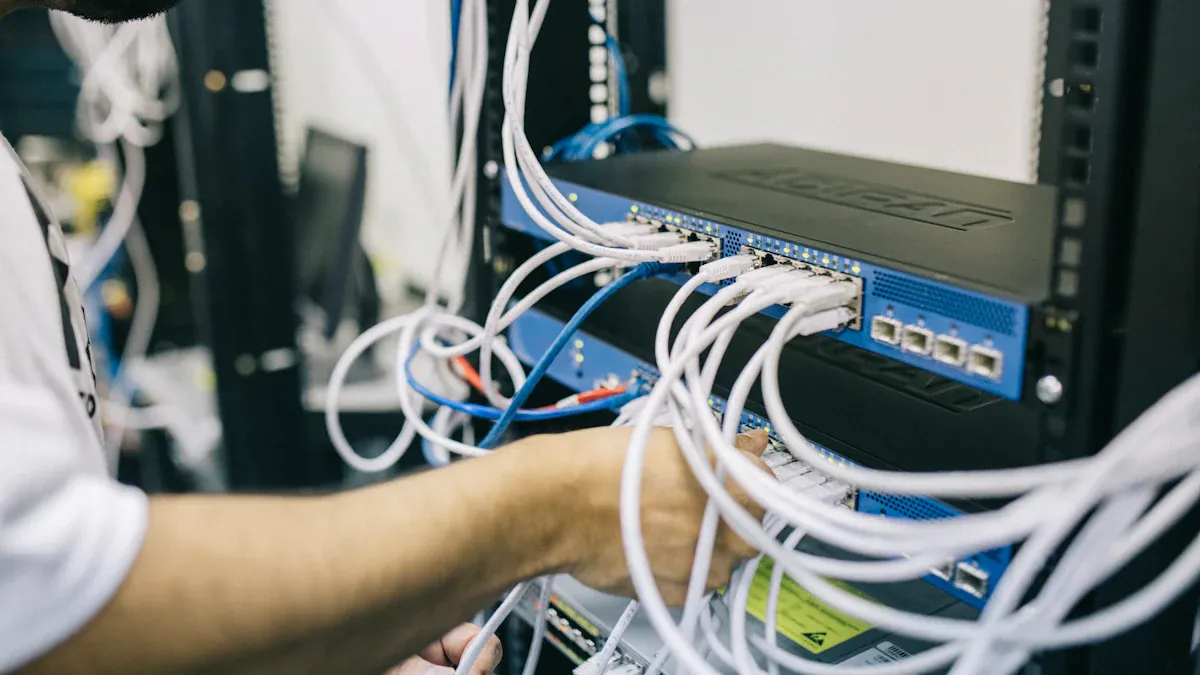
MPO trunk cables offer significant operational benefits for AI data centers. They streamline processes, reduce costs, and enhance overall network stability. These advantages are crucial for maintaining the demanding environments of AI infrastructure.
Rapid Deployment and Installation Benefits
AI data centers require quick setup and expansion. MPO trunk cables provide solutions for rapid deployment.
Reduced Labor and Time Costs
MPO/MTP systems dramatically cut down fiber installation time. They reduce it by 75-80% compared to traditional field-terminated methods. Projects that typically take weeks can finish within a single day. For example, two technicians can fully connect 3,456 fibers using MTP trunk systems in one 8-hour workday. Splicing the same number of fibers would require 24-30 working hours, showing a 3-4 times improvement in efficiency. The push-on design of MPO cables facilitates quick and secure connections. This minimizes setup time and labor costs. Pre-terminated solutions can reduce installation time by up to 50%.
| Metric | Before MPO/MTP Deployment | After MPO/MTP Deployment |
|---|---|---|
| Installation Time | 5 days | 2 days |
Minimized Downtime During Expansion
MTP/MPO cables simplify cable management. Their high-density connectors reduce clutter. This simplification leads to faster installation times and easier troubleshooting. It directly minimizes downtime during AI data center expansion or upgrades. The ease of maintenance allows network administrators to quickly address issues, implement upgrades, and perform routine maintenance with minimal disruption. MTP/MPO cables offer superior scalability and flexibility. They support multiple fiber strands in a single connector for higher density cabling and easier upgrades. This capability is crucial for hyperscale data centers. It enables quick network expansion and reconfiguration without extensive re-cabling. This future-proofs the infrastructure against increasing bandwidth demands. Nvidia MPO cables allow seamless integration into existing networks through a phased approach. This results in limited disruptions during the process.
Streamlined Cable Management with MPO Trunk Cables
Effective cable management is vital for the complex networks in AI data centers. MPO trunk cables contribute significantly to this efficiency.
Easier Troubleshooting and Maintenance
Proper cable management with MPO trunk cables makes troubleshooting and maintenance much simpler. Best practices include strategic planning and design. This prevents interference and facilitates future upgrades. Clearly labeling both ends of all cables with durable, easy-to-read labels streamlines troubleshooting and maintenance. This saves valuable time. An Intelligent Fiber Management System further improves operational efficiency. It integrates RFID electronic tags or port sensors to automatically detect connection status changes in real-time. This system automates record-keeping and accelerates fault localization from hours to minutes.
Improved Network Reliability
The robust construction and rigorous quality testing of MPO cables ensure a high level of reliability. This inherent reliability minimizes downtime and reduces maintenance costs. It contributes to smoother operations during data center expansion or upgrades. Structured cabling solutions, which often incorporate MPO trunk cables, organize all fiber components within a unified rack space. This optimizes airflow and reduces cooling energy consumption. The Intelligent Fiber Management System also enhances network security with real-time alerts for unauthorized access. This comprehensive approach to cable management and quality construction significantly improves overall network reliability.
Future-Proofing AI Infrastructure with MPO Trunk Cables
AI infrastructure constantly evolves. MPO trunk cables provide the adaptability and forward-thinking design necessary for future AI data centers. They support new architectural paradigms and advanced optical technologies.
Facilitating Disaggregated AI Architectures
Disaggregated AI architectures separate computing resources from memory and storage. This approach offers greater flexibility and efficiency. MPO cables are key enablers for this model.
Flexible Resource Allocation
MPO cables allow data centers to allocate resources flexibly. They connect compute, memory, and storage units independently. This modularity means operators can scale each component as needed. For example, they can add more GPUs without increasing storage capacity. This optimizes resource utilization and reduces waste. It also supports dynamic workload changes in AI environments.
Separating Compute and Memory
MPO cables facilitate the physical separation of compute and memory. This allows independent upgrades and scaling of each component. AI workloads often demand vast amounts of memory. Separating memory from compute nodes allows for specialized memory pools. These pools can be accessed by multiple compute units via high-speed MPO interconnects. This design improves overall system performance and efficiency.
Supporting Advanced Optical Interconnects for AI Chips
The future of AI relies on increasingly faster chip-level communication. MPO cables are crucial for these advanced optical interconnects.
Chip-to-Chip Communication
AI chips require ultra-low latency and high-bandwidth communication. This is essential for complex model training and inference. MPO cables provide the necessary pathways for direct chip-to-chip communication. They ensure data moves quickly between processing units. This direct connection minimizes bottlenecks and maximizes computational throughput.
Co-packaged Optics Integration with MPO Trunk Cables
Co-packaged optics (CPO) integrate optical transceivers directly onto AI chips. This technology brings optics closer to the processing unit. MPO trunk cables are crucial for integrating CPO within AI infrastructure. They provide a standardized, high-density interface for fiber optic connections. MPO connectors bridge the gap between integrated optical engines on ASICs and the broader fiber network. They support high-throughput, low-loss connections. MPO connectors will likely serve as the front-panel interface in early CPO-based switches. They can connect to flex optical ribbons leading to co-packaged optics. Their compact form factor is vital due to CPO’s thermal limitations. Hybrid systems combining MPO trunks with embedded optics will extend their relevance. The demand for MPO interconnects is driven by AI data centers. MPO’s versatility ensures its continued role in next-generation networking, even as optics move closer to the chip. Even with emerging technologies like co-packaged optics and on-board optics moving closer to or directly onto the switch ASIC, the need for high-density fiber cabling like MPO for rack-to-rack connections is unlikely to be eliminated. This highlights MPO’s continued relevance in AI infrastructure.
MPO trunk cables are indispensable for AI data centers by 2025. They deliver the performance, scalability, and operational efficiency these advanced facilities demand. Their role will continue to expand significantly. This solidifies their position as a critical networking component. They drive the ongoing evolution of AI infrastructure. Their robust design ensures future AI advancements have a reliable foundation.
FAQ
What are MPO trunk cables?
MPO trunk cables are pre-terminated fiber optic assemblies. They contain multiple optical fibers within a single connector. These cables provide high-density, high-bandwidth connections. They are essential for modern data center infrastructure.
Why are MPO trunk cables crucial for AI data centers?
MPO trunk cables provide the high-density and high-bandwidth interconnects AI workloads need. They support ultra-fast GPU communication and next-generation Ethernet. This enables efficient data flow for advanced AI applications.
How do MPO cables support high-speed AI interconnects?
MPO cables enable ultra-fast GPU-to-GPU links and AI cluster fabric connectivity. They support 400GbE and beyond. They also facilitate parallel optics transmission. This ensures the massive data throughput AI requires.
Do MPO cables help save space in AI data centers?
Yes, MPO trunk cables significantly reduce cable congestion. They integrate multiple fibers into one connector. This optimizes rack space. It also improves airflow and cooling efficiency within the data center.
How do MPO cables simplify network upgrades?
MPO cables feature a modular, pre-terminated design. This allows for rapid deployment and easy upgrades. Technicians can quickly swap or add cable assemblies. This minimizes downtime and simplifies network reconfigurations.
Are MPO cables future-proof for AI infrastructure?
MPO cables facilitate disaggregated AI architectures. They support advanced optical interconnects for AI chips. This includes co-packaged optics integration. Their adaptability ensures continued relevance in evolving AI environments.
What is co-packaged optics, and how do MPO cables relate to it?
Co-packaged optics (CPO) integrate optical transceivers directly onto AI chips. MPO trunk cables provide the high-density interface. They connect these integrated optical engines to the broader fiber network. This bridges the gap between chip-level optics and the data center infrastructure.

